S t a r M y t h s
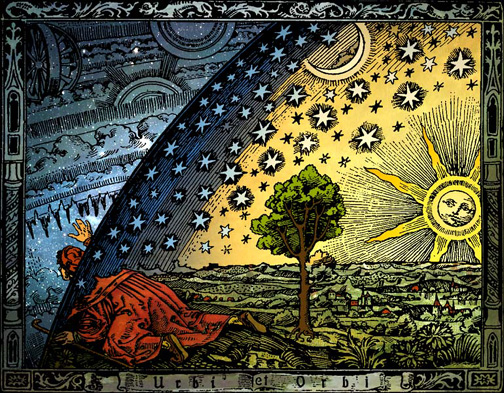
flammarion-woodcut
Hello!
Introduction:
I am going to introduce you to some of the ancient myths and folklore of the nightsky.
Before we get into the mythology, let’s start off by giving you a little background about what a ‘constellation’ is.
Constellations are the invention of the human imagination, and are not natural.
Basically, a constellation is like a ‘connect-the-dots’ picture, with the stars being the dots.
They are a human attempt to organize the wilderness of the Night Sky.
Ancient peoples had plenty of reasons for doing so:
Seafarers and caravan travelers needed a way to find their destinations.
Farmers and Herders needed a way to keep track of the seasons to help them figure out when to plant & harvest their crops, or move their animals from summer to winter pastures.
Therefore people devised ‘sky pictures’ or ‘constellations’ to help them remember these things and as an attempt to explain the natural phenomena of the night sky.
So constellations really tell us the stories and myths of the peoples who invented them.
I've focused on four general catagories of nightsky myths and legends, those associated with the Big Dipper (Ursa Major),
Orion the Hunter, the Pleiades star cluster, and the Milky Way.
The Legend of Ursa Major:
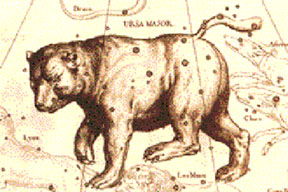
Among all the stars of the heavens, there is none so well known as this seven-starred figure.
This constellation is probably the most easily recognizable star pattern in the entire sky.
Almost every culture around the world throughout the ages had stories about the seven stars that we call the ‘Big Dipper’.
For example, the Chinese viewed the 7 stars as the images of the 7 celestial palaces of the
“Star God of Longevity” Shou Lao on the heavenly mountain of Tien Shan.
The Hindu see these bright stars of the Great Bear as the homes of the 7 Rishi or sages who are the masters of the reality of heavenly influences.
The Sumerians thought of these stars as a ‘Celestial Wagon’ or chariot.
And they weren’t the only ones to picture some type of cart among these stars.
Across Europe, you’ll find these stars called by the old name “Charles' Wain” ("wagon")
and according to folktale that it was named after the great King Charlemagne.
In the Northern European / Scandinavian countries of Viking descent,
it was commonly called ‘Odin's Wain’, after the Norse king of the gods.
The dim star Alcor, (double to Mizar), is called the Wagoneer and is considered to be the driver of the great wagon.
In England this pattern is still commonly called ‘the Plough’ referring to a farmer’s plough used to break the ground for planting crops.
In Celtic legend, the Great Bear is associated with King Arthur whose name is derived from the Welsh language ‘Arth’ or ‘Bear’ and ‘Uthyr’ or ‘Luminous’.
(so the name ‘Arthur’ means ‘luminous bear’).
In modern Ireland the figure is known as the ‘Starry Plough’ and has been used as a political symbol meaning that a free Ireland would control its destiny from the ‘plough to the stars’.
Today, in North America, it is universally known as the ‘Big Dipper’ because the major stars can be seen to follow the rough outline of a large ladle or dipper. This figure actually comes from Africa, where it was sometimes seen as a drinking gourd.
In the 19th century, (pre-Civil War era) runaway slaves used the celestial ‘Drinking Gourd’ to point the way to the north and freedom. The conductors of the Underground Railroad would teach a folk song called “Follow the Drinkin' Gourd” as a guide for the fugitive slaves to follow in the spring when they would attempt escape.
-------------------------------------------
Several Native American legends exist concerning the stars of Ursa Major as a bear.
One of my favorites is from the Iroquois.
The Bear is represented by the four stars of the bowl in the Big Dipper.
Bear is being hunted by three warriors named after birds, Robin, Chickadee, and Cowbird, as represented by the stars of the handle of the Big Dipper. Chickadee (star Mizor) carries a Pan, (the tiny star Alcor), in which he is planning to cook the meat of Bear.
These three stars are sometimes referred to as ‘the hunters who are always hunting’.
As Bear awakens from hibernation in the early spring, she leaves her Den in search of food.
The Den is represented by the circle of stars in Corona Borealis.
The Hunters spot her fresh tracks in the snow and begin the pursuit.
Bear is stalked by the Hunters throughout the spring and summer, slowly following her up thru the sky country and back down the other side. In late autumn, the Hunters finally catch up to Bear near the bottom of the sky country, close to the Earth. Bear rises up on her hind legs to fight the Hunters, but Robin takes careful aim and shoots her with an arrow and Bear falls over dead on her back. Blood from Bear’s wound sprinkles down on the forests of the land below and stains the leaves red. This is why tree’s leaves change color in the fall. Some of the blood stains Robin’s chest, and this is why these birds have red breast today.
Bear is cut up and cooked during the winter to feed the tribe, with Bear’s skeleton remaining in the sky low on the horizon, lying on its back. But, her spirit has already entered another Bear hibernating in her Den in Corona Borealis. In the spring, she re-awakens and leaves her den.
Once again the hunt begins anew, repeating each year for all eternity.
-------------------------------------------
The Greeks also saw a shape of a bear among the stars of the Big Dipper, and another smaller bear nearby. These bears named by the Greeks are Ursa Major and Ursa Minor.
The story of how these bears got up into the sky goes like this.
Long ago, there was a beautiful daughter of the king of Arcadia named Callisto.
One day, the great king of the gods, Zeus, noticed her accompanying Artemis, the goddess of the hunt. Zeus had the habit of seducing young maidens, and eventually he got around to Callisto and made her one of his many lovers.
Zeus tried to keep his affair with Callisto hidden from his wife, the goddess Hera.
But, in time, Callisto gave birth to Zeus' son Arcas, and Hera learned of it.
As punishment, Hera turned Callisto into a bear and banished her to roam the wilds.
Over the years, Arcas grew into a great hunter as a young man.
One day, while hunting far into the woods, he came upon an unusual bear in that it didn’t turn and run from him. Unknowing to Arcas, it was his mother Callisto.
Callisto having seeing her grown son, desired to speak with him and attempted to approach him but could only growl. Seeing the bear advance on him, Arcas grabbed his spear and drew his sword. To protect the son from killing his own mother, Zeus intervened.
He changed Arcas into a bear as well so he and his mother could be together.
As a rebuff to Hera, and to keep them from further harm, Zeus placed both of the bears high up in the sky out of Hera’s reach, but within her sight every night of the year.
It is said that the bears tails are longer than normal because of the fact that Zeus grabbed them both by their tails and swung them over his head flinging them upward. The tails stretched as the bears whirled around the great god’s head.
But Hera gets the last word in by forbidding the bears from ever resting beneath the Earth and that is why they can never set below the horizon like other constellations.
The Legend of Orion:
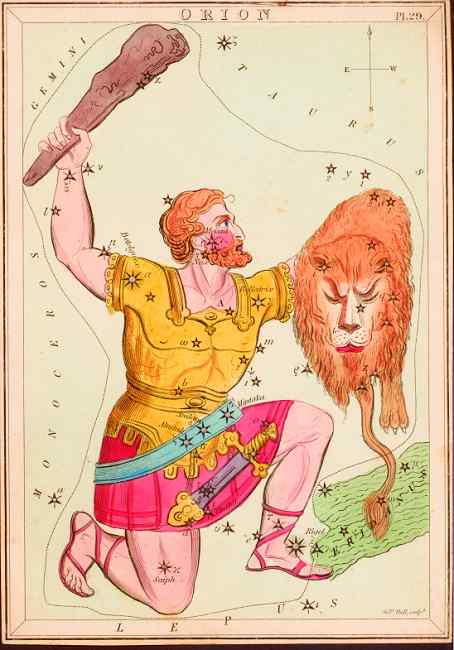
After the Big Dipper, Orion is the next most commonly recognizable constellation and is visible from every part of the globe. Almost every ancient culture associated this area of the night sky with a ‘star-god’ or ‘great warrior’. In addition to Orion’s brilliant first magnitude stars of Betelgeuse and Rigel, it holds the three equality-bright asterism of the hunter’s belt stars. Orion marked an important position in the skies around 4000 BC. The constellation coincided with the spring equinox and marked the first day of the year for many ancient cultures. This led to many interesting stories being associated with this starry area of the sky.
The Inuit thought of the three belt stars as trio of seal hunters.
According to the Australian Aborigines, the three stars are the ‘Dancing Young Men’ trying to attract the attention of girls, represented by the nearby Pleiades.
In ancient India, the Hindu saw this grouping of stars as the lord of all creatures.
To the Egyptians this constellation represented the solar god Horus.
He is depicted as riding in a boat with the nearby star Sirius as his mother, Isis.
In some Mesopotamian societies, Orion was known as Anu the shepherd, whose name meant ‘Light of the Sky’, and he was considered the king of heaven.
-------------------------------------------
The Wasco and Wishram Native American tribes of the Pacific Northwest saw in the stars of Orion a great struggle between Winter’s ‘Cold Wind’ from the east, and Spring’s warm ‘Chinook Wind’ from the west. According to legend, long ago when all stars were human beings, there lived an old grandfather who was a renowned salmon fisherman. Old Grandfather had three grandsons’, the strongest of which was named ‘Chinook Wind’. At the beginning of spring, the three brothers left on a journey to visit faraway relatives.
All summer long and throughout the fall, the tribe always had plenty to eat, thanks to Old Grandfather’s fishing skills. But then late in the fall, another fisherman from the east named ‘Cold Wind’, began stealing the fish from the river, so Old Grandfather caught less and less, leaving the tribe little to eat over the winter. Finally, in the midst of winter, the three brothers returned upriver in their canoe. Seeing how Cold Wind was stealing the fish from the people, Chinook Wind stepped forward to protect his tribe and ordered Cold Wind to stop stealing fish.
Cold Wind refused to give back the fish, so the two wrestled. Chinook Wind fought longer and harder and won the struggle. Cold Wind was banished back to the east.
To this day, Chinook Wind is stronger than Cold Wind and every spring forces Cold Wind to leave. You can tell that the time is near for Chinook Wind’s return when you can see him and his two brothers paddling their canoe up the celestial river.
(represented by the stars of Orion’s belt and sword!)
-------------------------------------------
The modern constellation that we know today from the Greeks, actually originated from the ancient Sumerians, who saw in it their great hero Gilgamesh.
The epic of Gilgamesh is probably the most complete legend connected with this constellation. Dating to over 4000 years ago, the epic was discovered inscribed on clay tablets found in the library at the ruins of the great Assyrian city of Nineveh.
Gilgamesh was noted for being a strong warrior, a leader, and a lady’s man.
(even the goddess Istar fell in love with him).
Listed among Gilgamesh’s feats are the slaying of an undefeatible giant who terrorized a local forest, and battling and defeating Taurus, the mighty celestial ‘Bull of Heaven’ sent to destroy Gilgamesh after he refused to become the goddess Istar’s husband.
In pursuit of immortality, Gilgamesh undertook an epic journey to the end of the world, where he had to cross mountains, deserts, and oceans, fighting off scorpion-men and various enchantments, finally re-discovering the lost ‘Garden of Eden’.
In the end Gilgamesh failed to achieve immortality, but learned that happiness for man was to be found in music, dance, festivities, and family.
br>
-------------------------------------------
The ancient Greeks named this grouping of stars after their hero Orion, where we get our classical representation of the great hunter kneeling with his raised right arm holding a club,
and a shield made from lion skin in his left hand.
According to mythology, Orion was born to a poor shepherd whose wife had died childless.
You might wondering how a man could have a child without a wife! The answer of course is the gods! One evening the king of the gods Zeus, along with his brother Poseidon and Mercury, were traveling thru the countryside. It was getting late, and they were far from any town, so they disguised themselves and stopped for the night at a shepherd’s house.
Not realizing the identity of his guests, the old shepherd offered what he had, made them comfortable, and sacrificed and cooked his last cow for their dinner. The gods, being greatly impressed by the old man’s hospitality, asked what one thing in the world that he wanted the most. The old shepherd replied that he wished he could have had a son.
Then Zeus, Poseidon, and Mercury revealed their true selves and promised to fulfill the shepherd’s wish. The gods gather around the hide of the cow that they had just eaten, performed a mystical ceremony, and bundled up the cow skin. A few months’ later Orion was born! As Orion grew he became a great hunter, and friend and lover of the goddess Artemis.
Before he met Artemis, Orion had fallen in love with the seven sisters of the Pleiades, persuing them such that Zeus had to place them up in the sky out of reach of Orion’s unwanted affections!
After Orion got over his love for the Pleiades, he went on to perform many deeds and feats and thru his love of hunting, he eventually met Artemis, goddess of the hunt.
The god Apollo, (brother of Artemis), became jealous of Orion and killed him with a scorpion. In her sorrow Artemis begged Zeus to place him in the sky among the most brilliant stars, where he could remain for all eternity with his hunting dogs Canis Major & Minor, chasing the hare Lepus. So Zeus honored Orion thus, depicting him as facing the snorting charge of Taurus the bull. Afterwards, Apollo insisted that the scorpion also be placed in the sky to commemorate the great hunter's downfall. Zeus agreed, but placed the scorpion on the opposite side of the sky so as one rises, the other always sets. Zeus also placed Sagittarius the Archer
next to the scorpion, with drawn bow aimed at the scorpion's heart, should the scorpion try to advance toward Orion and sting him again.
The Legend of the Pleiades:
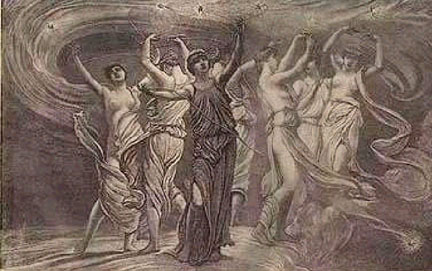
Glittering like a swarm of fireflies, there is a grouping of small stars that are so distinctive, that many cultures regard it as it’s own mini-constellation. The Pleiades or ‘Seven Sisters’ is actually an open star cluster located within the constellation of Taurus the bull.
There are ancient temples erected all over the world that are aligned with these stars. Some cultures have considered them the center of the universe or the destination of the soul when a person died.
The Pleiades are mentioned by numerous authors from down the ages. Texts from ancient Egypt, Greece, Rome, China, and elsewhere link this fuzzy patch of stars to all sorts of religious matters and even more practical things such as when to plough the fields and plant crops to their harvest, and even when to sail on the sea.
-------------------------------------------
The start of winter was marked in some cultures by the Pleiades first appearance in the evening sky. The Celts thought this marked a period (centered on the date around November 1st where Pleiades culminated, or reached their highest point at midnight) where the boundary between the living world and that of the dead crossed. Like a doorway opening, this allowed visitors to either side. In the Middle Ages, this became known as the fearsome Witch’s Sabbath, or Black Sabbath. This lead to our present day holiday of Halloween!
In Mesopotamia: The stars of the cluster are associated with the seven sons of the goddess Istar. Praying to them helped as protection against evil demons.
The Egyptians called the month of November a word that meant ‘the Month of the Pleiades’.
Within the Great Pyramid at Giza a tunnel directed toward the south corresponded precisely to the meridian crossing of the Pleiades, and whose passing through that opening, at midnight, marked the beginning of the year, and renewal of the Pharaoh’s soul.
The Mayan people watched the sky with great interests and kept very accurate track of the lunar and solar cycles, and Venus’s appearance in the evening or morning skies. Every 52 years, when the Mayan sacred and secular calendars synched up, they considered the midnight meridian crossing of the Pleiades as a very significant and ominous event, as the world could come to an end during that crossing! In fact, their sacred history tells them that the world has already been destroyed and re-created four separate times in the past! So to prevent this from happening, they held many great religious ceremonies involving numerous human sacrifices to appease the gods.
-------------------------------------------
Other cultures had a more practical use for watching the celestial movements of the Pleiades.
Japanese fishermen who called the star cluster ‘Subaru’, saw a kind of fish net made of stones and bamboo and used rising and setting of the bright "net" to determine when to cast their own nets into the sea.
The Greeks referred to the Pleiades as the ‘Sailing Ones’, as they were visible all night during the summer sailing season. When the Pleiades disappeared from the sky, the Greeks knew it was time to beach their ships in preparation for the winter storm season.
-------------------------------------------
Other common European names for the Pleiades: The Finns called it the ‘net.
The Swedes had a name that translates as ‘Fur in Frost’.
The Welsh referred to it as the ‘Dog Pack’.
In Germany, they were called ‘Hen and her Chicks’.
The Danes called it the ‘Eve Hen, and Russian farmers named it the ‘Sitting Hen’.
-------------------------------------------
Native American Navajo children learned that by watching the Pleiades star cluster in the sky, (which they call Dilyehe), they can tell when it’s time to plant, and when to harvest.
According to Navajo lore, a goddess called Spider Woman, taught them about Dilyehe and other star figures so they would know their relationship with the stars, sun, and all of nature.
The Pawnee tell a story that the stars that make up the Pleiades are six brothers who saved their little sister from an evil rolling skull. The Cherokee tell about seven boys who so loved to play a game called ‘chunky’ (involving rolling a round stone with a stick), that they forgot all about their chores, their family, and everything else.
So much that they became light headed and rose up into the sky country, where they are still playing! They call these stars Anitsutsa (a-ni-su-sa), which means, ‘The Boys’.
The Cheyenne have a legend that connects the Pleiades and the eroded volcanic mountain core in Wyoming called “Devil’s Tower”.
(if you ever watched ‘Close Encounters’, that’s the mountain).
According to lore, the Great Spirit raised up the mountain to protect seven Indian maidens who were being pursued by giant bears. But the bears were so persistent that the Great Spirit had to place the maidens up into the sky country to finally save them. The marks of the giant bear’s claws can still be seen to this day on the sides of the mountain!
-------------------------------------------
In Greek mythology, the Pleiades are the seven daughters of the sea nymph Pleione, the ‘Queen of Sailing’, and the giant Titan Atlas, who was condemned by Zeus to hold the weight of the world on his shoulders.
All seven sisters are named and each has their own stories:
• Alcyone - `queen who wards off evil storms', is the brightest star of the cluster.
• Asterope - `starry, twinkling', one of the lovers of Zeus.
• Celaeno
• Electra - `shining, bright', mother of Dardanus, the first king of Troy.
• Merope - `eloquent', only Pleiad to marry a mortal.
• Taygete - `long-necked', mother of Lacedaemon, founder of Sparta.
• Maia - `the eldest and most beautiful' sister, mother of the god Hermes, messenger of Zeus.
• In modern times, two fainter members of the star cluster have been given the names of Atlas & Pleione to honor their parents.
Only six stars are easily visible within the star group.
The seventh is considered the ‘Lost Pleiad’.
This sister is said to be Electra, who veiled her face at the sack & burning of Troy (the great city which founded by her son), by the Greeks.
The short version of how the Pleiades were placed up in the sky goes like this:
One day as the sisters were traveling in the countryside, they were chased by Orion, who had fallen in love with them at first sight. In their fright they prayed to Zeus to save them. In pity he turned the sisters into doves that flew up into the sky. Zeus placed them up in the night sky where Orion could see them, but never catch them.
The Legend of the Milky-Way:
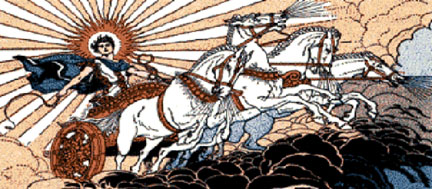
Living today in the 21st century’s light polluted skies, we can seldom see the beautiful splendor of the Milky Way, which can be viewed on a clear, moonless night. The light from any nearby city will obliterate much of the faint haze like glow in the night sky that we know of today as our own home galaxy.
But people living just a few hundred years ago, before the age of electricity or gas lamps had little trouble viewing the Milky Way.
Across the ages, various peoples and cultures attempted to explain what the Milky Way was.
-------------------------------------------
The ancient Greek astronomers came up with all different kinds of theories trying to explain this glow up in the night.
Some saw it as a collection of stars whose light was partially obscured by the shadow of the Earth. Others thought it was a great mass of luminous vapor higher than the ether but lower than the planets. There were some that claimed it marked the former path of the sun, and still others who thought it was the seam in the sky where the two seams of the celestial vault didn't quite fit together. Finally, there were a few who speculated that it was thousands of suns that were extremely far from the Earth and not very bright (a pretty accurate theory!)
-------------------------------------------
Some of the more ‘non-scientific’ myths of the Milky-Way:
Mesopotamian cultures thought of the Milky Way is that of smoke rising to the gods from sacrificial offerings.
The Australian aborigines also saw it as the smoke of the campfires from an ancient people.
The Egyptians saw it as the Great River Nile extended into heaven by the goddess Isis.
In India it was known as the Bed of the Ganges River.
The Chinese thought of the Milky Way as the River of Heaven,
where the mothers of the Sun and Moon bathe their children before they enter the sky.
Also, acording to old Chinese household folklore, the Milky-Way is a wide river that seperates two star-crossed lovers represented by the stars Altair and Vega.
Only once a year can the two reunite for one night.
The story goes like this:
A young cowherd named Niulang (the star Altair), came across seven fairy sisters bathing in a lake.
He stole their clothes and only agreed to give them back if one of the sisters would marry him.
The youngest and most beautiful of the fairy sisters, Zhinü (the star Vega) agreed to his request for marriage.
They lived happily together and had two children.
But the Goddess of Heaven found out that Zhinü, a fairy girl, had married a mere mortal.
The Goddess was furious and forced the fairy back to her former duty of weaving colorful clouds, a task she had neglected while living on earth with a mortal.
On Earth, Niulang was very upset that his wife had disappeared, so he carried his two beloved children off to Heaven to find Zhinü.
The Goddess discovered this and was very angry. Taking out her hairpin, the Goddess scratched a wide river in the sky to separate the two lovers forever, thus forming the Milky Way between Altair and Vega.
Zhinü must sit forever on one side of the river, sadly weaving on her loom, while Niulang watches her from afar and takes care of their two children (represented by Altair's two flanking stars).
But once a year all the magpies in the world would take pity on them and fly up into heaven to form a bridge ("the bridge of magpies", Que Qiao) over the nearby star Deneb, so the lovers may be together for a single night, which is the seventh night of the seventh moon.
Various Middle-Eastern cultures referred to the Milky-Way as the ‘River of Light’.
In northern parts of the world, the Norsemen saw it as the path that souls take on their way to the afterlife. A cosmic bridge linking Heaven and Earth used by the Valkries as they carried the souls of warriors slain on the battlefield to feast in honor in Valhalla, the halls of the gods.
They called it ‘Odin’s Way’ or sometimes the ‘Asgard Bridge’ and thought it was created from the ‘Bifrost rainbow’ by the gods.
-------------------------------------------
The Cherokee Native American tribe saw the Milky Way as a trail of ground cornmeal scattered across the sky by a wayward dog that was stealing it. As he was chased away, the cornmeal spilt out behind him. In southeastern North America, the brightest section of the Milky Way is visible in late summer and early fall, right at the time of the corn harvest. The Cherokee call it ‘Where the Dog Ran’.
The Navajo of the southwest desert had a similar creation story involving Black God and the trickster Coyote! On the first evening, the gods of creation met in the first hogan to discuss what they had made in the world that first day, and to plan what to put in it next day. Black God arrived last with a leather bag full of colorful crystals. The other gods asked him to fill the dark sky with his crystals to make it beautiful and to provide humans with guides for living on earth. So Black God reached into his bag, pulled out a bright crystal and carefully placed it in the northernmost reach of the sky. It became the North Star.
Next he pulled out seven smaller crystals and placed them up in the sky.
The Navajo call this Dilyehe (Pleiades).
Throughout the evening, Black God pulled crystals of various sizes and colors out and one at a time thoughtfully placed them in the sky and named them. After Black God created all the known star patterns, he sat down to admire his handiwork. Coyote, arriving late to the meeting, decided he too wanted to help put stars in the sky. So while Black God was busy looking up at his creations, Coyote grabbed the bag in his mouth and ran outside. But his sharp teeth caused the bag to tear, spilling out thousands of tiny crystals all along the way. These tiny crystals rose up in a jumble into the sky, forming a glowing path behind Coyote as he ran, obscuring some of the star patterns Black God had just created.
Black God scolded Coyote for leaving chaos and disorder in the night sky, but Coyote just laughed, giving the now empty leather bag back and saying, ‘now the skies are truly beautiful’!
-------------------------------------------
Finally, classical Greek mythology describes the Milky Way in a number of colorful stories. One story described it as a smear of mother’s milk left after the infant Hercules nursed milk from the goddess Hera to gain her wisdom.
When Hera realized that the child was the illegitimate son of Zeus, she pushed the baby away and spilt milk across the heavens to become the Milky Way.
Another popular Greek explanation says the Milky Way is the burned scar across the sky formed when Phaëthon, son of Apollo, tried to drive the chariot of the sun and couldn’t control the horses. Apollo would take Phaethon along with him on his daily trips with the sun chariot thru the sky. Phaethon longed to drive the chariot himself, but Apollo forbade him. One day, Phaethon’s desire overcame his fear, so he arose before dawn, and hitched the horses of Apollo to the sun chariot, which they were use to his doing. Then he mounted the chariot, cracked the reins, and began the ascent into the heavens. At first all went well as the horses thought it was their master Apollo doing the driving. But through Phaethon’s overconfidence, the horses soon realized it was not Apollo and began running wildly. Phaethon could not bring them back under control, as the horses would only obey Apollo.
The chariot weaved back and forth across the sky, sometimes coming too close to the Earth, turning the lands below into great deserts, other times coming too close to the dome of heaven scorching it. Zeus, fearing that Phaëthon’s uncontrolled flight would even burn up Mount Olympus, the home of the gods, took out one of his thunderbolts and zapped the chariot, killing the driver. Apollo was able to regained control of the chariot’s horses’, and return the sun chariot to its proper celestial path. Ever since, no one else other than Apollo has been allowed to ride in or drive the sun chariot!
Conclusion:
These myths that I’ve shared with you tonight are represented by some of the brighter stars and constellations. Using starcharts, you can go out and locate them up in the night sky.
While you’re stargazing at them, think about the myths and stories behind them,
and that for thousands of years, people just like ourselves have been gazing and wondering about those very same stars, and sharing the stories and myths handed down to us from our ancestors.
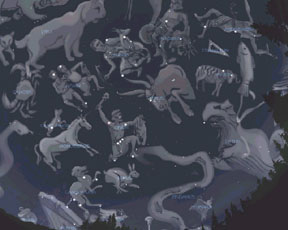
Credits:
“Scientific American” Nov 2006 – ‘Origin of the Greek Constellations’ by Bradley Schaefer
“Star Tales” by Ian Ridpath
“They Dance in the Sky – Native American Star Myths” by Jean Monroe and Ray Williamson
“Burnham’s Celestial Handbook” by Robert Burnham Jr.
“The Glorious Constellations: History and Mythology” by Giuseppe Sesti
“The Stories in the Night Sky” website: http://www.ufrsd.net/StaffWWW/Stefanl/myths/index.htm
“The Constellations” website: http://www.dibonsmith.com/stars.htm
"Stellarium" planetarium software: http://www.stellarium.org/
"Chinese Qixi Festival" http://en.wikipedia.org/wiki/Qixi_Festival
Hope you enjoyed the visit. Come again soon!
Larry McHenry, Pittsburgh, PA. USA






